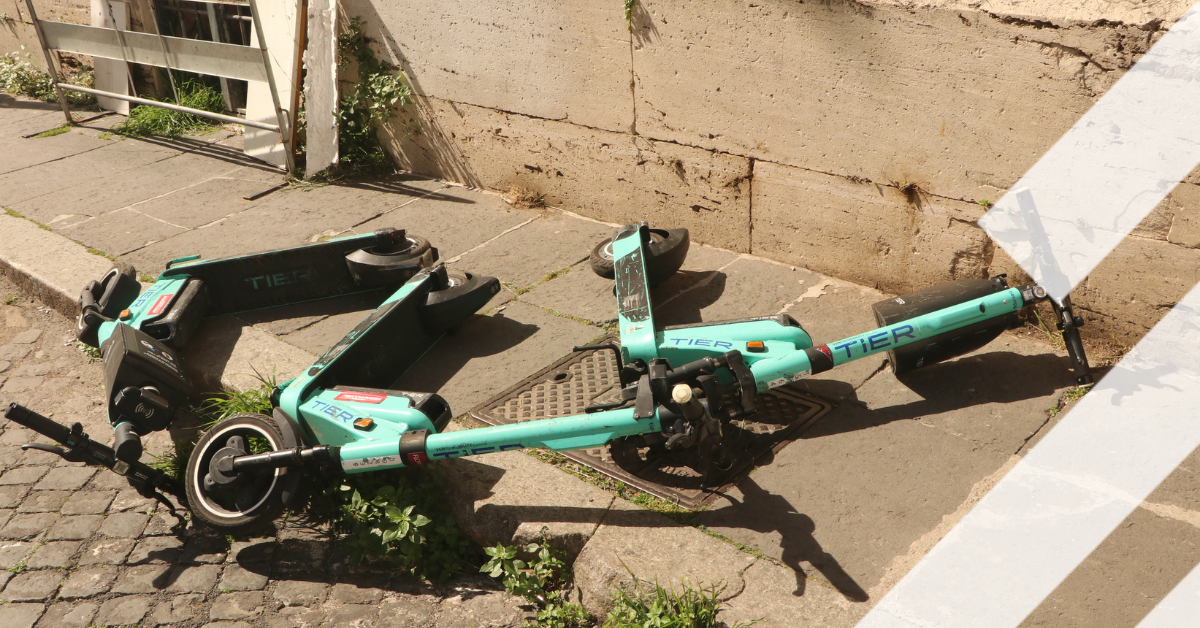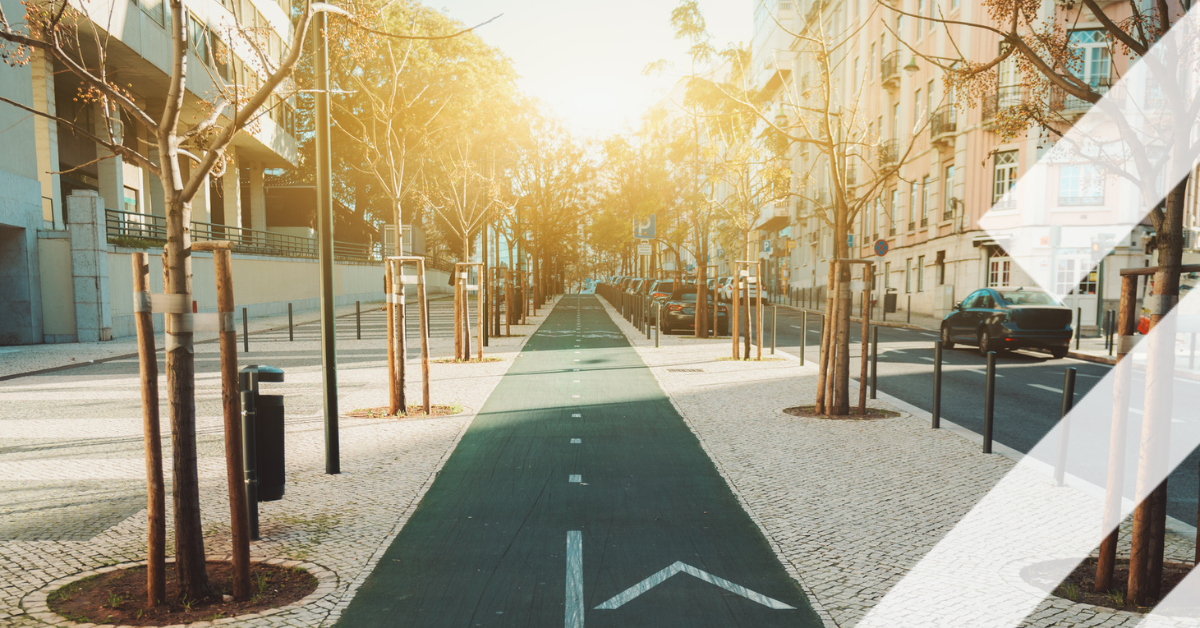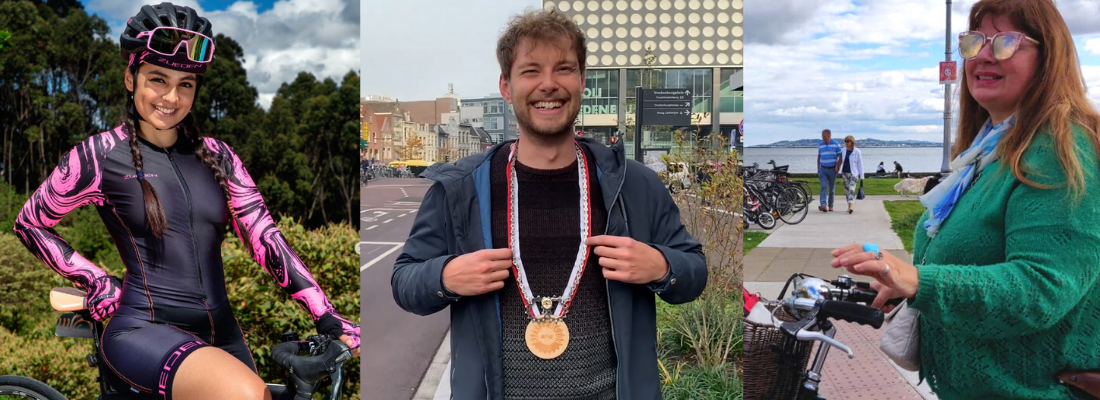People around the world choose the bicycle more often since the outbreak of COVID-19. Did you know, the world counts 130 Bicycle Mayors? They are part of the international network BYCS. In this third edition of this series we take a look at Utrecht (NL), Bogota (Columbia) and Dublin (Ireland), with different challenges asking for different solutions.
Jelle Bakker – Bicycle Mayor of Utrecht, the Netherlands
Making cycling inclusive for every citizen
Jelle was appointed as Bicycle Mayor recently by the Mayor of Utrecht. He proudly shows us his chain of office made out of a bicycle chain! We spoke to him in Frame, a bike repair and coffee shop in Utrecht.
‘I am very excited and proud to be the Bicycle Mayor of Utrecht. The city is doing very well when it comes to cycling. And this is necessary, 58% uses the bicycle to get into the city centre. The municipality puts a lot of effort in our infrastructure, parking garages and priority rules for cyclists. This is great, however there is one thing we seem to forget and that is to make cycling inclusive for everyone. Exactly my focus as a Bicycle Mayor.’
Safe to cycle
‘One of the challenges of cycling in Utrecht, is safety. We have one of the busiest cycling paths in the world with over 18,000 cyclists a day and there has been a big shift in cycle modes with an increase of electric and cargo bikes and speed pedelecs. If you are not used to these modes, if you are not that mobile any more or in case you still need to learn how to cycle, cycling can become difficult and you feel less secure. I feel a strong responsibility to make cycling accessible to everyone.’
‘We have one of the busiest cycling paths in the world with over 18,000 cyclists a day and the biggest bicycle parking garage that has 12,500 parking spots.’
Cycle as long as possible
‘Physically, there comes a time you can no longer cycle, but we can at least help you do it as long as possible. Being mobile makes people less lonely. Utrecht became a ‘Doortrappen’ or ‘Cycle-on’ community. This project assists elderly to cycle. We offer specific cycling exercises to remain flexible for instance to turn your head to watch traffic behind you. With bicycle choice help, we explain what kind of bicycles are available. Getting off the bike can be a challenge, so elderly tend to lower the saddle. However, this hurts the knees after a while, so we advise them to use a special designed saddle.’
‘Another group of attention to me, are children with special needs. Now, these children are taken to school by bus. This costs the local government around 2,000 euros per child per year and parents are very reliant on the driver’s schedule. It is my ambition to improve their mobility too by setting up lessons, but also by offering them adapted bicycles. An adapted bicycle can cost up to 8,000 euros, so it is impossible for parents to buy. Since we already have a lot of shared bicycle solutions, why can’t we work together with those platforms and offer an (electric) tricycle, a duobike or other adapted bikes in very neighbourhood? Inclusive shared mobility is my ambition.’
Cycling is freedom
‘Utrecht is a cycle centred city; your reach is much wider on a bicycle. It gives freedom and it is better for your health. My main responsibility is to know what is happening, connect parties and organisations. Maybe we can even match refugees to elderly to help each other. In order to get an idea of the needs of the people, I plan to organise special cycling office hours in the neighbourhoods. I invite people to have a chat in a café or a community centre during set hours and share their ideas and needs with me. A bottom-up approach!’
Donna Cooney – Bicycle Mayor in Dublin, Ireland
Bicycle as the most important invention for women’s freedom of votes in 1918
Donna Cooney applied for the position of a Bicycle Mayor in 2018 to be ready for Velo City taking place in Dublin in 2019. She is also an artist, cycling activist and Dublin City councillor.
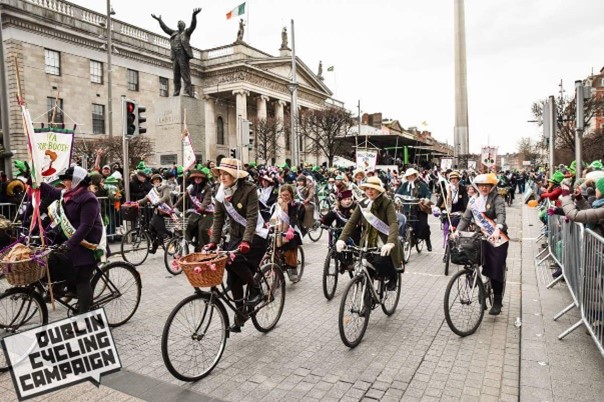
The Freedom Machine
‘It all started in on St. Patrick’s day 2018 when we campaigned for cycling with our project called the Freedom Machine. In 1918, 100 women went out on a bicycle to promote freedom for women. At the time, women were restricted to home, clothing was restrictive, they did not go out unaccompanied and weren’t allowed to vote. In the early 1900’s women decided to use the bicycle and went out on the streets protesting for equality and votes for women. From that moment on the bicycle was seen as the most important invention and symbol of freedom for women. In 2018 we celebrated the centenary of the successful campaign for votes for women in 1918 by doing the same and using banners with visuals of that time.’
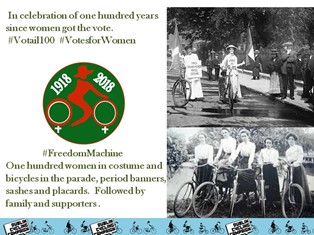
‘There was a cartoon of a male Madonna that showing that if you let women ‘out’ on their bicycle, you will be doing all the domestic work as a man yourself.’
Cycled backwards
‘In the first part of the 20th century, the propaganda against women cycling became huge. For instance, there was a cartoon of a male Madonna that showing that if you let women ‘out’ on their bicycle, you will be doing all the domestic work as a man yourself, women would become less productive, you would have less babies, etcetera.’
‘It seems like we have gone backwards when it comes to cycling. Up until one generation ago, cycling rates were a lot higher, even among women and children. My grandfather had a car, but it only came out for trips to the countryside. To work, he would cycle. Photographs show a lot of people on a bicycle. Now, only one in four women are cycling; (probably due to safety and infrastructure). Expert’s studies show that the quality of your cycling infrastructure is directly connected to the percentage of women and children cycling. Reason’s for lower numbers of female cyclists in research in Dublin include fear of injury, verbal harassment, fashion, discouraged by parents, safety etcetera.’
Joyce-Cycle
‘My main focus is to promote cycling among women and children. Dublin is very well known for writers. During the St. Patrick’s Parade in 2019 in our project called ‘Joyce-Cycle’, we combined famous writers promoting cycling. People dressed up as characters or we had books on our backs. We also re-launched the musical on the history of the bicycle ‘Spokesong’ by Stewart Parker and how it can change the world. It is not very well known as it should be, but in its time it even travelled to New York and around the world.’

‘I am very lucky, because in Ireland we have a budget of around one million per day to spend on cycling and active transport. We are putting together a cycling team, including junior bicycle mayors. Also, a lot effort and budget needs to be put in infrastructure, greening, place making, education. Another challenge for Dublin is pollution. A lot of polluted water ends up in the bay, so we are improving planting to make sure the surface water is absorbed.’
‘In Ireland, we have a budget of around one million per day in Ireland now to spend on cycling and active transport.’
Improving cycling infrastructure and parking
‘As I mentioned, a lot should go into our infrastructure. Up until recently we only had plans for segregated cycle-ways on our major arterial routes, but without the connecting streets. Plans now look like a spider’s web and when completed they will provide safe routes from home to any destination. We are also trying to arrange the 30km an hour speed limit as a standard in the entire city. However, we have a number of local authorities in Dublin and not all of the councils agree, because 30km an hour is not possible some people say. For instance, Bicycle Island, which I want to change to 15kmph, but they prefer 40 km.’
‘In order to increase safety and cycling among children, we organise children’s cycle buses. In feedback from our surveys parents report being are very nervous about their children cycling to school. So now volunteer parents are cycling on the outside and children cycling on the inside. It is great fun! Hopefully, it will become safer with 30km an hour and segregated cycle routes. The kids can be more independent.’
‘Another challenge for the future when we do well in promoting cycling is parking. We need more indoor bicycle parks and I am happy that my suggestion to the Dublin City has resulted in cooperation with existing car parks to provide bicycle parking. We also plan for more bicycle parking at train stations and new train city carriages that can carry bicycles.’
Bicycle future
‘I am very happy with new developments such as shared mobility. I don’t have a car; I do have a membership on a shared car and I also use shared cargo bikes, which go 78km without a charge. Businesses can put their logo on the cargo bikes.’
‘The most exciting project for 2022 will be the start of a new partnership in Dublin between BYCS, Trinity College and Dublin City Council where we will be working with youths designing for their futures with place-making and cycling routes in their communities. These examples and more can be shared among cities. I enjoy making more connections with the other Bicycle Mayors to learn from them and share experiences in their countries. It is really good to have this network.’
Laura Carolina Pava García - Bicycle Mayor in Bogota, Colombia
As bicycle mayor Bogota I want to highlight some challenges we have faced with the use of bicycles. In Bogota there are a large number of cyclists and it is no secret that it is one of the cities in the region that moves more cyclists; citizen processes have been super important and thanks to projects such as the ciclovía have been formed, which is a pioneering project that brings together more than one or almost two million people who every Sunday ride a bike, ride a skateboard, go for a walk with family and friends, that's just to give you an example. The importance of citizenship has been key, a few years ago the district administrations, the mayor's offices, did not pay attention to active mobility in a city with a lot of traffic problems and it was the citizens who put cycling at the center of the public conversation, that should be highlighted, but now what is happening, Bogota is living a moment in which there are many opinions and a great diversity of thoughts, The socio-political context has also been complex, but I believe that I have the capacity for conciliation and that my work as a journalist has had a positive impact on groups in disagreement with the district as well as with the district itself.
We have seen an increase in bicycle use in Bogotá over the last years. I got on a bike in 2012 and since then it has been visible, before you didn't see so many cyclists on the street, the number of cyclists that come out today is very high. The Secretary of Mobility of Bogota, stated that the number of cyclists grew by 80% during the pandemic, measuring from April 2020 to December 2020, the number of cyclists that before were 350 thousand daily trips, went to 650 thousand almost 700 thousand trips, the dynamics of the pandemic said that we should not approach, that we should have a safer movement and the bicycle was certainly the solution for many workers and students to mobilize. So there is a very large increase and I would also like to point out that there is a study that was done at the Universidad de los Andes here in Colombia together with Grupo Sur, which is also part of the Universidad de los Andes, in which they talked about the characteristics of the people who rode bicycles; they stated or suggested that between 2000 and 2014, people who got on the bike, have a passionate feeling, they are motivated by because they like to ride a bike, while people who got on from 2015 onwards have other reasons a little more diverse as the quality of traffic, because as we have been talking about, the traffic in Bogota is very chaotic and public transport does not offer the guarantees for safe, comfortable, economical travel, then people got on the bike.
Safety strategies
In terms of road safety and personal safety, the District has created safety strategies together with the national police. For example, safe routes have been created for imprisoned cyclists, in Bogotá we have 6 safe routes, we have a registry and control in bicycle stores, it seems to me that it is still very incipient, let's say that I would like this type of controls and operations to be carried out every day at all hours, because the sale of stolen bicycle parts is still a problem that has not been solved in Bogotá, however, it is being done. A heat map was also created with the incidence of thefts in different sectors in Bogota so that we as citizens have that information and make better decisions when riding a bike and also in terms of road safety I would like to highlight some role plays that have begun to be done from the administration, public transport which is the public transport system here in Bogota and drivers and cyclists, then role plays are made where drivers put themselves in the cyclists' shoes literally and start to pass them by one side and start to realize the importance of the distance of the meter with fifty, that when you ride a bike accidents can inevitably happen, all this generates a little more empathy in drivers, because they put themselves in our position and say "yes, I should not commit these actions because it may result in that I can take the life of that cyclist".
When I started cycling, the number of women who rode bicycles was very low compared to what it is now. In Bogota, cycling has diversified a lot because it is no longer only people who ride bicycles to go to work or to their place of study, but also groups have been formed in the localities, in the universities; For sports, people who train outside the city or people who are competing even at an international level and who are young people who began to ride bicycles in the velodrome and began to join, they realized that they had a great potential to ride bicycles so they began to generate income and began to generate as these groups of amateur and even professional cycling, has encouraged them to always try to increase or increase the number of women in these groups; these groups that before were mixed groups, now we also see women's groups. There are many women's groups: women bike-messengers who have created women-only groups, women who ride bicycles in Colombia demonstrating that women can also make this type of long-distance trips, competitions focused 100% on women. I think that the use of bicycles by women has increased a lot, also because we have the possibility to show what we do in our social networks and that inspires other women. When I got on the bike, I didn't see almost no women and I was very afraid that I was making a mistake against my safety, I said, people tell me that it is very dangerous to ride a bike. I'm doing it against all odds because I don't have much experience, but I'm still going to take the risk because I think I also have the right to move in a different way in the city where I live, so when I started to see more women, I started to be inspired by them because I said "if she can, I can too" and so we began to see that many girls are already generating digital content, many girls are starting to run national and international competitions and also the issue of improving the conditions for us. I want to highlight very much the "Congress 50/50 more women on bikes" that was held in 2019 here in Bogota and that was really a very inspiring space for us as leaders, to realize that we are really on the right track, that we have a long way to go, but we want that of the 10 cyclists who ride a bike in Bogota, 5 are women and 5 are men, we want there to be parity in the use of bicycles and we are also working together with district entities and also with private companies.
Project "Una rola en bici"
I am a journalist, so when I started my internship I started in a newspaper that had the project of creating more digital content and in that process, in that work, a project was created called "El rincón de la bici" which was a project to make videos of Laura riding a bicycle telling her experience about how it is to ride a bicycle, and from there many topics began to emerge and we began to notice that it started first of all a pioneering content because there was not much information on social networks at that time, which was almost 4 years ago, there was not much information given by women cyclists to the audience, let's say that from there we began to notice that lack of information and when I disengaged from the newspaper I started to do my independent project. I called myself "Una rola en bici" because we are "rolos" from Bogotá and because I also wanted to highlight the importance of the city, my city, in my experience, so let's say that the objective of "Una rola en bici" is to be the communication channel for cyclists in Bogotá and I would like to expand it to Colombia, to the world, I would like to give information for road safety, information for personal safety, information on infrastructure, information on bicycle trips that I also do, information for women on bicycles, etc. It is a channel that condenses all the experiences that I have been able to observe being a cyclist here in Bogota.
When I became independent thanks to a call made here in the District and in which I was able to go to Mexico City to see how mobility was there and I learned many things and from there "Una rola en bici" was born, also obviously influenced by Bogota which is the center of my audience. People from Ecuador have also participated thanks to the World Bike Forum that was held in Quito in 2019 and to which we went pedaling from Bogota, then also many people were able to connect with "Una Rola en Bici".
If people want to connect with me, I am present on YouTube, on Instagram, which is the platform where I am most active, Facebook, Instagram, TikTok and everywhere they can find me as "Una Rola en Bici".
I would like to take this opportunity to highlight that we did a forum of women on bicycles, since October when I was appointed Mayor of the Bicycle, there we could talk about what is it that prevents us and what is it that motivates us to get on the bike. I also did the National Bicycle Forum, I went to the National Bicycle Forum in Bello Antioquia pedaling from here in Bogota, it was more or less 400 km with a very large group, it was a great experience because it was pure companionship on the road; I would also like to highlight my participation in the Escuelita de Patios which is, well Patios is a climb that is here in Bogota and is very traditional, it is like the climb that cyclists who are just starting to ride a bike go to, they are always told "You have to go to Patios" it is the traditional climb for cyclists. What do you want with the Escuelita de Patios? Well, to encourage more people to climb, which is not at all easy, it is 7 km of ascent, they are hard. Finally, Bicitur is also a program to roll with Denmark, it is also super "cool" to support those processes that are already consolidated, that already have some very important leaders, but thanks to the participation of more people, they begin to grow.
We have had a safety talk for cyclists because the District is going to start implementing a robbery prevention strategy, so they gave us very important tips to know how to move and to detect robbery alerts. Here in Bogota, unfortunately, cyclists are being robbed and not only are they being robbed, but they are being injured for stealing their bicycles, they are being killed for stealing their bicycles. I believe that the task is to unite as a cycling community to confront, not so much to not allow ourselves to be robbed because at the moment of being robbed, even yesterday we were told "let yourselves be robbed and move away from the place", that is a strategy to avoid being victims, but let's say that we manage to form a group so solid that we manage to dismantle gangs dedicated to bicycle theft.
